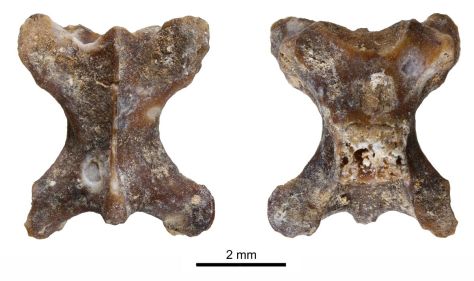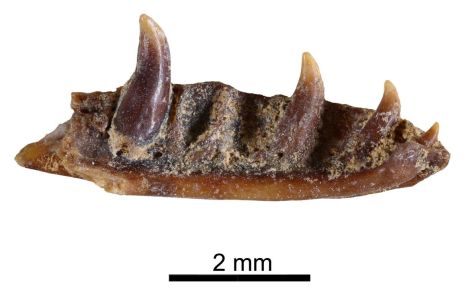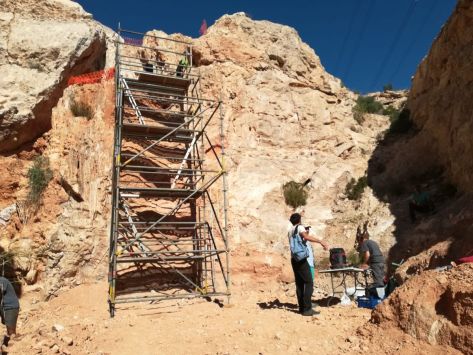NewsNext Previous
A new species of reptile: a lizard without legs that lived in Murcia one million years ago
The discoverers have dedicated the new species to the paleontologist Miguel Ángel Mancheño, first director of the excavations in the Murcian site of Quibas, where it has appeared
The findings shows that the southeast of the Iberian Peninsula was the last ecological refuge for subtropical species in Western Europe
Hugues-Alexandre Blain, researcher at IPHES (Institut Català de Paleoecologia Humana i Evolució Social), in collaboration with Salvador Bailon from the National Museum of Natural History in Paris (MNHN), have described a new species of lizard without legs of the genus Ophisaurus, family of the Anguidae as the slowworm, present today in the Iberian Peninsula. The remains found include: a maxilla, three jaws, two parietals, numerous vertebrae and an osteoderm. The find is dedicated to Miguel Ángel Mancheño, Professor and paleontologist from the University of Murcia and former director of the Quibas excavations (Abanilla, Murcia), where the fossil remains that gave rise to the new species are from. Thus, the new lizard has been named Ophisaurus manchenioi. Judging by the recovered fossil remains, and the knowledge of the current lizards of this type, it is thought to have about 40 centimeters length.
The genus Ophisaurus is currently represented by other species living in the tropical and subtropical environments of North Africa (Morocco and Algeria), North America and Southeast Asia. The paleobiogeographic analysis of the genus shows that it appeared in Europe during the Eocene (56 and 34 million years ago), and that it had its maximum extension during the Miocene (between 23 and 5.3 million years ago). During the Pliocene (between 5.3 and 2.6 million years ago), its distribution in Europe was restricted to the Mediterranean. It survived longer in the south of the Iberian Peninsula, which apparently acted as a refuge area. The species eventually became extinct one million years ago, with its last mention in the site of Quibas, in Murcia.


During the Pliocene (between 5.3 and 2.6 million years ago), its distribution in Europe was restricted to the Mediterranean. It survived longer in the south of the Iberian Peninsula, which apparently acted as a refuge area. The species eventually became extinct one million years ago, with its last mention in the site of Quibas, in Murcia.
“Until now, the fossil presence of this genus was known in other Early Pleistocene sites of the Iberian Peninsula, such as, Barranco León and Fuente Nueva 3 (Granada, Spain), but its key defining element -the parietal, a bone from the skull -was not available to compare it with the other fossil species defined from: this bone”, points out Hugues-Alexandre Blain, IPHES researcher and co-author of the scientific article that published the finding. “Osteologically, this new species is more closely related to the fossil species Ophisaurus holeci from the Miocene of Germany and the Czech Republic than to its modern North African representative (Ophisaurus koellikeri)”, he adds. “That is why we can say that it is a European relict species and that it does not come from a landbridge between North Africa and the South of the Iberian Peninsula”, he points out.
By comparison with the other extant species of the genus, it can be inferred that this reptile had tropical or subtropical ecological requirements. Its extinction at the species level in the Iberian Peninsula and in Europe coincides with the progressive disappearance of certain subtropical arboreal taxa (Cathaya, Elaeagnus, Engelhardia, Eucommia, Liquidambar, Keteleeria, Nyssa, Sciadopitys, Symplocos, Pretoria, Parthenocissus, Pterocarya and Tsuga). “Consequently, the extinction of this reptile is contemporary with the disappearance of the last haven with subtropical conditions (warm and humid forests) in southern Europe around 1.2 million years ago, during a period of very important climatic changes known at the transition from the Early to Middle Pleistocene”, notes Hugues-Alexandre Blain.

Since its discovery in 1994, the paleontological site of Quibas (Abanilla, Murcia) has yielded, the fossil remains from more than 70 species of the late Early Pleistocene, around 1 million years old. “It is a karstic site whose importance lies in the great diversity of fauna, excellent preservation of the remains and the possibility of finding human evidence”, says Pedro Piñero, current co-director of the excavations in Quibas and collaborator of IPHES.
Remarkable also is the presence of fossil bones from: macaques, large felids, lynxes, foxes, musk oxen, goats, rhinoceros, deer, porcupines, bearded vultures, eagles (or ibis), as well as a long taxonomic list of small vertebrates, including: hedgehogs, mice, dormice, shrews, bats, snakes, vipers, geckos and agàmid lizards. “Research concerning these remains highlights the importance of this site, now with the presence of a new species previously unknown to the scientific community, as is the case of this new lizard,” says Pedro Piñero.
The studied material from this new lizard species was revealed from excavation campaign dating to 2006. Revision of these fossils is part of the new project, inscribed in the research project CGL2016-80000-P “Climatic crises of the Early and Middle Pleistocene and its incidence in the evolution of the microvertebrate communities of the Spanish Levante” and in the research group of the IPHES Human Paleoecology of Plio-Pleistocene (PalHum). AGAUR-Generalitat de Catalunya, 2017SGR-859.
Bibliographic reference
Hugues-Alexandre Blain & Salvador Bailon. 2019. Extirpation of Ophisaurus (Anguimorpha, Anguidae) in Western Europe in the context of the disappearance of subtropical ecosystems at the Early-Middle Pleistocene transition. Palaeogeography, Palaeoclimatology, Palaeoecology. https://doi.org/10.1016/j.palaeo.2019.01.023


